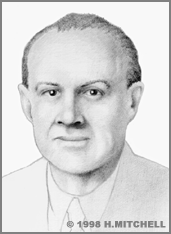John Hammond
John Hays Hammond was both a whimsical and practical inventor: his interests ranged from music and cooking to electronics and torpedoes. Born into a privileged family in 1888, Hammond would never have to look far for inspiration to invent; among his family’s friends were the Wright brothers, Thomas Edison, and Nikola Tesla.
Hammond’s own first invention came after he had entered the Lawrenceville School in New Jersey in 1903. It was a sensor and circuit breaker that he built into the door of his dorm room, which automatically cut off the room’s lights when the door opened, allowing students to circumvent the school’s 8:00 p.m. “lights-out” rule. Hammond was happy to wire many of his fellow students’ rooms, but years later, when the same kind of device became common in refrigerators and cars, Hammond regretted the fact that he had not followed Edison’s earlier advice to him: “Patent all your ideas, and get yourself a good lawyer.”
Hammond went on to the Sheffield Scientific School of Yale University, where he met Alexander Graham Bell, concentrated in telephony and radiodynamics, and earned a bachelor’s degree in Science (1910). Despite his privileged background, Hammond took a humble position as a clerk at the Patent Office in Washington because he wanted a secure grasp on what new work was being done in his favorite fields. At the same time, he convinced his father to advance him $250,000 to found his own company in Gloucester, Massachusetts.
Hammond began experimenting with radio-operated remote controls in earnest. By 1914, he had laid the foundations for all subsequent radio control, by incorporating a gyroscope into the receiving system of a “ghost ship” that he piloted around Gloucester Bay. His “Gyrad” system allowed Hammond to send an unmanned yacht on a successful 120-mile trip from Gloucester to Boston and back. With World War I just beginning, Hammond added an anti-interference feature that would prevent others from jamming his system’s signals. He also invented a target-seeking system that allowed a remote-controlled ship to hone in on an enemy ship’s searchlights, and he began work on the first radio-guided torpedo. By 1916, he had earned over 100 patents, as well as the appreciation of the U.S. War Department.
After World War I, Hammond focused on radio transmission. He was a pioneer in frequency modulation (FM) broadcasting, invented the single-dial radio tuner, and licensed a patent in telephone amplification to Bell Telephone. During the Second World War, Hammond’s major invention was a variable-pitch propeller, which maximized efficiency by automatically adapting to the conditions of the water through which it was running.
Among the more quirky inventions of Hammond’s career were a magnetic bottlecap remover, a hypodermic meat baster, a “panless” stove with a disposable aluminum surface on which food was cooked directly, and a failed cure for baldness. His most grandiose project was the 10,000-pipe organ installed in the “Gothic castle” that he had built as his home in Gloucester.
By the time of his death in 1965, John Hays Hammond, Jr. had become a famous world traveler and socialite, as well as a respected engineer, entrepreneur, and inventor.


